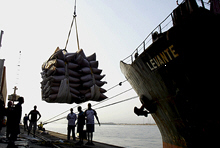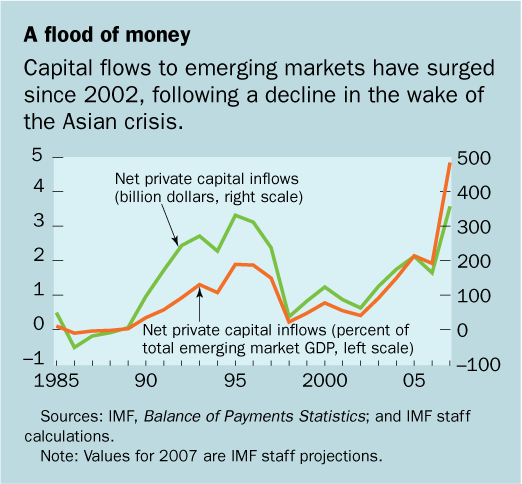
Typical street scene in Santa Ana, El Salvador. (Photo: iStock)
IMF Survey: Learning How to Cope with Capital Inflows
October 10, 2007
- Capital inflows to emerging market economies proving to be mixed blessing
- They help deliver economic benefits of increased financial integration
- Can also lead to overheating, loss of competitiveness, higher vulnerability
The strong increase in net private capital inflows to emerging market economies over the past few years is proving to be a mixed blessing.

Countries with relatively high current account deficits have been more vulnerable to sharp reversal of capital inflows (photo: Paulo Whitaker/Reuters)
POLICY RESPONSE ANALYSIS
Although these flows help deliver the economic benefits of increased financial integration, they also create important challenges for policymakers because they can lead to overheating, a loss of competitiveness, and increased vulnerability to crisis.
While a number of studies have examined the policy responses to capital inflows in the 1990s focusing on a limited number of country cases, there have been fewer studies involving recent episodes of capital flows and even fewer attempts to systematically compare how different countries have responded in terms of new policies.
Key points:
The main question: Although private capital inflows can result in long-term benefits if put to good use, they may pose significant risks to macroeconomic stability. What policy measures were adopted in the past to counteract instability, and did they work?
Learning from experience: Although the appropriate policy response to large capital inflows depends on country-specific circumstances—in particular, the nature of the inflows—a comprehensive cross-country analysis of policy responses over the past two decades may provide guidance about what has worked and what hasn't.
Main lesson: The most robust lesson from our analysis is that keeping government spending along a steady path—rather than engaging in excessive spending during periods of heavy capital inflows—helps mitigate the adverse effects of large inflows.
A chapter in the October 2007 World Economic Outlook entitled "Managing Large Capital Inflows" tries to fill this void by reviewing the experience with large capital inflows over the past two decades in a large number of emerging market and advanced economies. Our goal was to describe the various policy responses to these experiences and assess their macroeconomic implications. We focused on two main questions:
• What policy challenges are created by surges of net private capital inflows?
• What policy measures were adopted in the past, and did they work?
Episodes of large capital inflows
There have been two great waves of private capital flows to emerging market countries in the past two decades (see chart). The first began around the early 1990s and then ended abruptly with the 1997-98 Asian crisis. The recent wave has been building since 2002, but has recently accelerated markedly, with flows in the first half of 2007 already far exceeding the total for 2006.

Both country- and region-specific criteria were used to identify episodes of large net private capital inflows. An episode was defined as a year or a series of years in which the ratio of net capital inflows to GDP for a particular country not only had to be large in historical terms but also needed to exceed a regional threshold. Using this approach, we identified more than 100 episodes of large net private capital inflows since 1987.
Identifying, measuring policy responses
The "impossible trinity" paradigm of open economy macroeconomics—the inability simultaneously to target the exchange rate, run an independent monetary policy, and allow full capital mobility—suggests that, in the absence of direct capital controls, countries facing large capital inflows need to choose between nominal appreciation and inflation. In practice, however, given that capital mobility is not perfect (even in the absence of direct capital controls), policymakers may have more scope to pursue intermediate options than this paradigm would suggest.
Indeed, the influx of large capital inflows has generally induced policymakers to adopt a variety of measures to prevent overheating and real currency appreciation, and to reduce the economy's vulnerability to a sharp reversal of the capital inflows. Our analysis focused on four policy measures: exchange rate policy, sterilization policy, fiscal policy, and capital controls.
We identified four key lessons:
• Countries with relatively high current account deficits have been more vulnerable to a sharp reversal of capital inflows because they have been particularly affected by increases in aggregate demand and the real appreciation of their currencies.
• Keeping public expenditure growth steady during such episodes—rather than ratcheting up spending—can contribute to both a lower real exchange rate appreciation and better GDP growth performance in the wake of inflow episodes.
• Attempts to resist nominal exchange rate appreciation have generally not been successful in preventing real appreciation and have often been followed by sharper reversals of capital inflows, especially when these inflows have persisted for a longer time.
• Whereas capital controls might have a role to play in certain cases, our analysis shows that restrictions on capital inflows have, in general, not facilitated lower real appreciation and a soft landing.
In sum
Stabilization challenges arising from large capital inflows are most serious for countries with substantial current account imbalances. The most effective tool policymakers have at their disposal to avoid overheating and output instability is likely to be fiscal restraint—avoiding any abrupt increases in spending during inflow episodes—especially in the context of relatively inflexible exchange rate policies.
Our research also suggests that even if a central bank initially intervenes to resist nominal exchange rate appreciation when capital inflows begin, this stance should be progressively relaxed if the inflows persist. This is because it becomes less likely that such a policy will succeed in preventing real appreciation and a painful end to the inflows.







